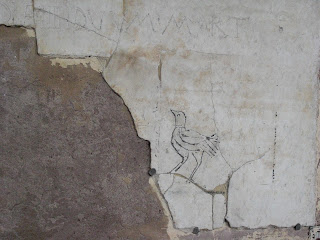Having once been fooled or, rather, been naive enough to believe reviews on TripAdvisor, I've become leery about hotel and restaurant recommendations - except in person, that is. Let me say, before I continue, that only once did I feel we ate badly in Italy and that probably was because we were too tired after a night flight and a walk around Rome to take a taxi on a wet night to a recommended restaurant. We stayed in the neighborhood of the hotel and ate, not actually badly, but certainly gracelessly in a room reserved, it appeared, for tourists who did not speak Italian. And therein, not speaking the language of the country one visits, lies the essence of the problem.

Assuming, as I must, that you and I are of like mind, let me say that we all have a list of places we want to visit; the architectural icons, repositories of history and culture, that frequently play a role as signifiers of quality in advertising, serve as identifiers of location in movies and television drama - for which film star has not been involved in a car-chase by the Ponte Vecchio, the Duomo, the Colosseum, the Eiffel Tower, Houses of Parliament, depending on the need for local color in what are increasingly homogeneous cityscapes?

In most cases, modern guide books and travel magazines serve us well, but my skepticism is awakened when I read recommendations especially of those secret, known-only-to-the-writer, small off-the-beaten-path restaurants serving gobsmacking food from a kitchen the size of a closet, furnished with a miniscule stove and staffed by a man who learned to cook at at the knee of nonna - a woman who used no recognizable means of measuring - and whose wine is always local if not from his own vineyard. The world is too small for this or that
best kept secret and probably if somewhere has been unknown for so long there is a good reason. Anyway,
best kept secret really just means
now being marketed.
Of course, it's the language of persuasion: the use of superlatives; the implication that if one goes to these places; is able to get a reservation; eats this ineffable food, one becomes a member of a select band of great refinement, and, latterly, is able to have yet another set of photographs for Facebook.
But what of food - that purely late-twentieth and early-twenty-first-century reason for being a tourist? Before this vacation, our experience of
Italian was limited. Not that we subscribe to the tomato-saturated pasta, greasy garlic bread and overdressed salad - staples of chain restaurants that rely heavily on family and friendship in creating their image
. No, we are blessed with two, to my mind, excellent Italian restaurant restaurants here in Atlanta, which coincidentally are my favorite places to dine.
Last Friday, not a week after we came home, we ate at one of them and during that meal mulled over what I had eaten in Italy compared with what was on the plate before me. In one of the two local restaurants, Pricci, I usually eat fettucini alfredo with a dusting of nutmeg and, in the other, Veni Vedi Vici, spinach gnocchi with gorgonzola, speck and cream. I worked out a long time ago - and I recognize this might be considered picky eating or even a lack of curiosity - that when you find a dish to your taste, stick with it: a situation that cannot obtain in a city unknown to one, and nor should it. If either fettucini alfredo or gnocchi were on the menus in Rome, Florence and Venice, I have no recollection, for we were at pains to eat local, as it were.
On the subject of breakfasts, let me say that they were of superb quality, varied, and more than ample. Coffee, for that is my choice at breakfast, was of two sorts - the delicious smear of dark brown liquid with
crema, or what is known, tragically in my opinion, as
caffè Americano - the Italian version of the swill available in any gas station or restaurant in this country. What a pity that such a thin, stewed, brown liquid should be called American!
In Florence we ate very well, as we did in Rome and Venice. Breakfast at the Hotel Savoy was perfect and sufficient to keep us going through long cold days of walking until late afternoon when a chilled Manhattan served with
aperitivi - delicious tapas-like snacks that accompany every drink - sustained us for our walk to dinner.
When we arrived at La Pentola d'Oro, we were shown to a basement room of white-clothed tables. We asked instead to sit upstairs in the main room by the door, on wooden stools at bare tables where it seemed to me, locals - and so it proved - were more likely to eat.
Pappardelle alla lepre, wide noodles in hare sauce, were perfect for the Celt and surprisingly good to me. But, oddly, I'm not sure what I ate though I clearly remember telling the waitress, and meaning it, that it was one of the best things I'd ever eaten. I suspect what I ate was
il pepos del Brunelleschi, beef in red wine, but mostly I remember the smiling face of a young baby lying quietly by her parents and who seemed to be so happy to see me.
Cibrèo, highly recommended, was disconcerting at first and my heart sank when we were told that someone would come to the table and explain what that evening's menu was. Perhaps Cibrèo is aimed at tourists, as I surely felt it was, but it turned out it didn't mean the food was unconsidered or the experience poor. In fact it was excellent. After the manager sat at our table and explained in perfect English that the restaurant specialized in game - the mention of roast pigeon made the Celt's eyes light up - I had the distinct feeling I was in the wrong place. The Celt, indeed, chose roast pigeon stuffed with fruits in mustard (marvelous combination) whereas I went for what I thought was a fish stew. Fish it was, if squid are fish, and stew it was if squid cooked slowly with spinach for hours make it a stew. What arrived at my side of the table was unprepossessing - a bowlful of dark green sludge that at first I couldn't even consider dipping a fork into it. I tried it, declared I was unable to eat it. The Celt, who had just begun dissecting the pigeon with all the delicacy of a surgeon, murmured sympathetically, and I being the big boy I am, speared a tiny amount on the tip of one tine, then another and another and another until, three or four minutes after announcing I couldn't possibly eat this damned muck, I was wolfing it down.

Walk we did, as in Rome, seemingly all over the city, but really within quite a small area, for the
centro storico of Florence is not big. Brunelleschi's Pazzi chapel, part of the church of Santa Croce, where Michaelangelo, Galileo, and Ghiberti are buried, and the ruined Cimabue crucifix hangs, is a beautiful and subtle feast for the eyes - its interior as empty and as beautiful as the grey skies above it. The chapel, it struck me as I shivered my way around it, does not have the grand scale some textbook photographs have implied. It also occurred to me that as a tourist one needs balmier days and more supportive shoes if one is to do the job properly.
The perfect pre-prandial to get used to the idea of getting out in the cold again. With the
aperitivi.
A fellow guest. Probably not a local.
Photo of the Basilica di Santa Croce from
here. All other photos by the Celt.




















































.JPG)













